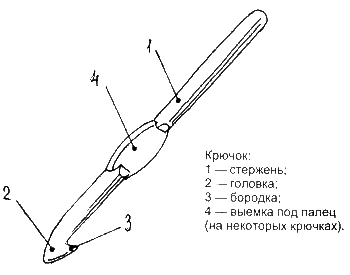
Figure 492.

Figure 493. Varieties of hooks
In operation, the hook is held like a pencil or pen while writing: the thumb and forefinger of the right hand, holding and directing the middle finger. The movement of the hands when knitting should be rhythmic.
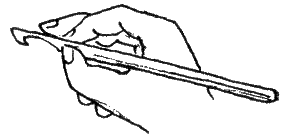
Figure 494. The position of the hand with a hook
Crochet vymazat loops of various shapes and sizes. Alternating loops, you can get all sorts of pictures. Crochet is also possible to sew and embroider. But we will consider only the techniques and opportunities that "help the spokes".
1. THE INITIAL LOOP
Grab the ends of the yarn the thumb and forefinger of the left hand.

Figure 495.
From the working thread from right to left to make a loop.
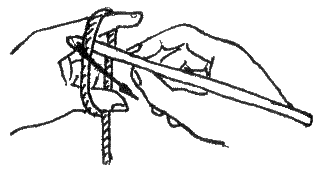
Figure 496.
Working thread placed on the index finger (under the loop) and hold it between the pinky and ring fingers.
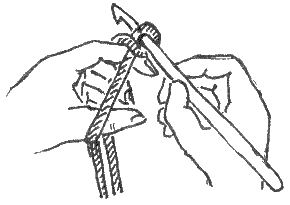
Figure 497.
Hook to enter the loop, grab the working thread and tighten the loop.
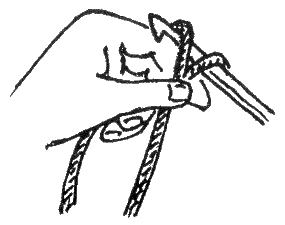
Figure 498.
On the hook work loop, which begins crochet a chain of air loops.
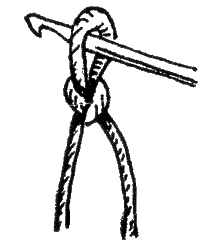
Figure 499.
2. AIR LOOP
Working thread over the hook and pull it through the loop on it. Thus get a chain of air loops, which begins knitting.
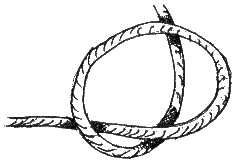
Figure 500.
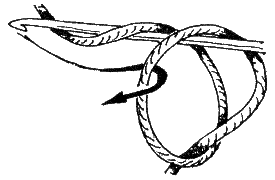
Figure 501.
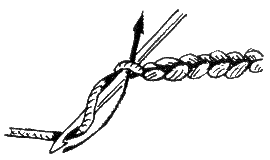
Figure 502.
3. POLYTYPIC
Enter the hook in the 2nd loop of the chain, not counting the loop on the hook, grab the working thread, stretch it through the loop of the chain and the loop under the hook, etc. of each loop of the chain.
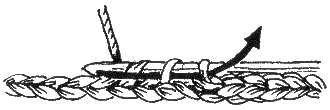
Figure 503. Polytypic
4. COLUMN WITHOUT NAKIDA
Chain 21 loop:
1st number - enter the hook into the 3rd loop of the chain, not counting the loop, are on the hook, grab and pull the thread again to grab the thread of the hook, i.e. to make yo, stretch it through both loops that are on the hook, etc. of each loop of the chain;
2nd and all following rows, turn work, knit into the 2nd air loop (loop region), enter the hook in the 2nd loop of the base, to grab and pull the thread, make a yo and pull it through both being on the hook loop.
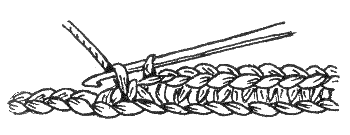
Figure 504. Column without nakida
5. A COLUMN WITH ONE NAKIDA
Chain 22 of the loop:
1st row: make SC, enter the hook into the 4th loop of the chain, not counting the loop on the hook, grab and pull the thread, make a yo and pull it through 2-e are on the hook loop, 1 yo, stretch it through the remaining 2 loops, etc. in each loop of the chain. Work to turn;
2nd row instead of the 1st column to link 3 air loop for the edges (2 for height, 1 for width), do yo, enter the hook in the 2nd loop of the base (1-y connected 3 air loop), it is possible to introduce the hook under both transverse filament loops of the base or just under the top (near) or lower (far), grab and pull the thread, 1 yo, stretch 2 lying on the hook-and-loop, 1 yo, stretch it across the 2 remaining on the hook loops, etc. of each loop the base;
3rd row: as 2nd.
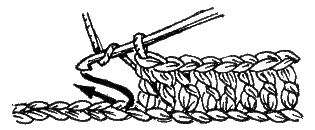
Figure 505.
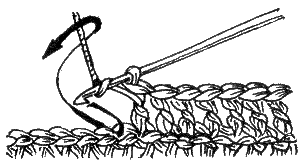
Figure 506.
6. POLYTYPIC WITH STITCHES
Chain 21 loop:
1st row: make SC, enter the hook into the 3rd loop from the edge of the chain, not counting the loop on the hook, grab and pull the thread, 1 yo, stretch it through the 3 loops are on hook, etc. of each loop the base;
In the figures (507, 508) shown polostevichi with stitches only on the front side of knitting.
Turn doing the following:
2nd row- region - 2 air loop, 1 yo, enter the hook in the 2 nd loop base, 1 yo, stretch it through the 3 loops are on hook, etc. of each loop the base;
3rd row: as 2nd.
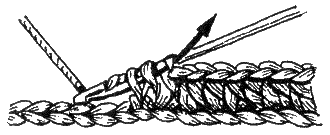
Figure 507.
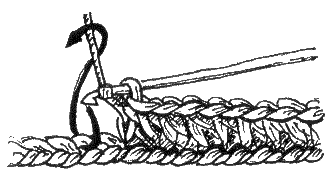
Figure 508
7. A COLUMN WITH TWO YO
Chain 23 of the loop:
1st row- 2 nakida, enter the hook in the 5th loop from the edge of the chain, not counting the loop on the hook, grab and pull the thread: 1 yo, stretch it through 2 loops, 1 yo, stretch it through 2 loops, 1 yo, stretch it across the 2 remaining on the hook loops, etc. of each loop the base;
2nd row - 4 air loop - region, from the 2nd loop reason to associate the column with 2 yo, etc. of each loop the base;
3rd row: as 2nd.
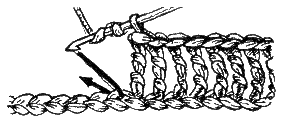
Figure 509. A column with two yo
8. A COLUMN WITH THREE OR MORE YO
For vyvazhivanija of this column is on the hook throws 3 or more nakida and stretch every time yo through 2, alternately lying on the hook loop. When you turn the work to knit a chain of 5 or more loops depending on the height of the column.
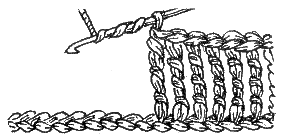
Figure 510. A column with three or more yo
9. A CROSS-SHAPED COLUMN
Chain 22 of the loop:
1st row- 2 nakida, enter the hook in the 5th loop of the chain, not counting the loop on the hook, pulling the thread and purl it together with stitches, 1 SC, skip 1 loop, pulling thread and 4 admission to crochet through all loops are on the hook each time (using 2 loops), 1 air loop, 1 yo, enter the hook into the place of crossing of the bars and 2 admission to crochet through all loops are on the hook. Making 2 nakida, enter the hook into the next loop of the chain and cross link the column.
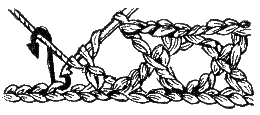
Figure 511.
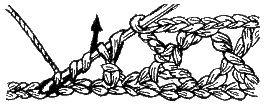
Figure 512.
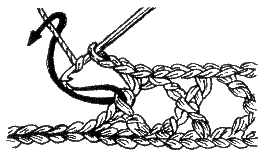
Figure 513
10. SCALLOPS
Tie 6 loops, enter the hook in the right loop of the chain, pull the thread, make a yo and knit into both stitches, to link with 5 loops of the chain and enter the hook into the 6th loop, counting from that which is on the hook.
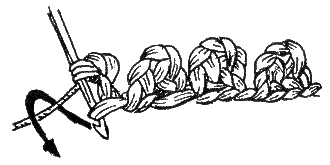
Figure 514. Scallops
11. PICO
Linking chain of 3 loops, a hook to introduce in the 1st loop of chain and pull it through the working thread, make a yo and knit into both stitches, tie 3 loops of the chain and enter the hook into the 4th loop, counting from that which is on the hook, etc.
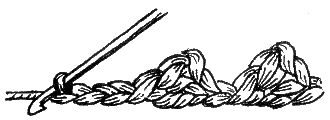
Figure 515. Pico
12. TRIM EDGE
One polytypic, 4 air loop, from 1-St knit columns without nakida, skip 2 stitches of Foundation, etc.
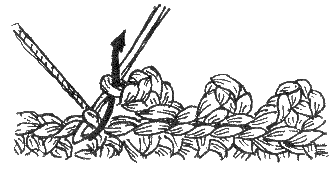
Figure 516. Trim edge
13. TEETH
Five of the stitches, knit Poustovit of the 2nd loop of the chain (counting from the hook) from the following loop chain to tie a column without nakida next loop to link polytypic with one of the last stitches and loop chain to associate a column with one nakida. Making the teeth to make chain of 5 loops for the next tooth.
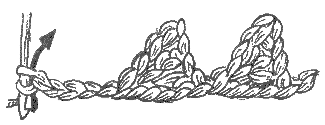
Figure 517. Teeth
14. LUSH COLUMN
Chain 15 loops:
1st row- from the 4th loop of the chain to knit a lush post, make 1 yo, enter the hook into the 4th loop of the chain, pulling on 1-1,5 cm working thread, 1 yo, from the same loop of the chain pulling on the same length of the working thread and so repeat 2-3 times (optional). The more nacidos, the more magnificent the column. Then all the loops are on the hook to crochet through in 2 admission (lush bars you can make various combinations, reminiscent of flowers. Figure 518-bars are 4-petaled flower, * 1 air loop, 1 nebazhannya lush column of the same loop base (i.e., all loops on the hook that need to be repeated in 2 hours until you knit across the row), skip 1 loop, 1 nebazhannya lush column, then 2 admission to purl 2 together nadopasana lush bar. From * repeat to end of row. At the end of number 1 air loop, 1 lush column of the same loop base, 1 column with nakida from the last loop of the base;
2nd row- 1 lush a column from junction 2 of the lush bars * 1 air loop, 1 nebazhannya lush column of the same loop base, 1 nebazhannya lush column of the following junction 2 of the lush bars, purl 2 together nadopasana lush bar. From * knit to end of row. At the end of number 1 air loop, 1 column with nakida from the last loop of the base;
3rd row: as 2nd.
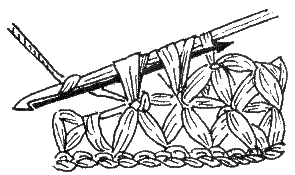
Figure 518.
In figures 519, 520 are shown crochet 6-petal flowers and lush bars.
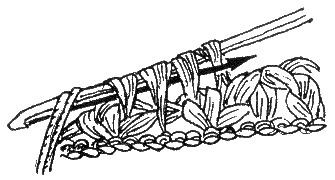
Figure 519.
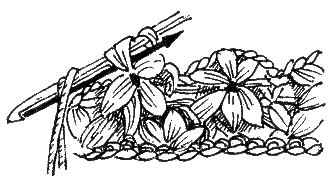
Figure 520.
15. USEFUL TIPS
The two strands can be linked in several ways (figures 521, 522 a-d):

Figure 521.
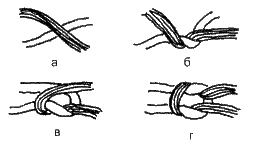
Figure 522.
Beginners knitting often lose bars at the edges of the canvas or vymazat superfluous. In order to avoid this, when knitting the first column, the hook should be entered in the 1st loop of the base (it is the thread from which the associated edge). If you mistakenly enter a hanging hook in 1st loop, and the second in the series will be one column less, and if you enter that loop, from which crocheted edging - will be another column.



